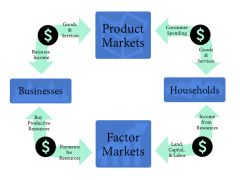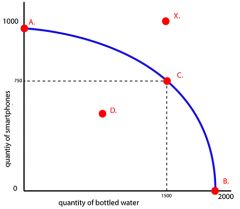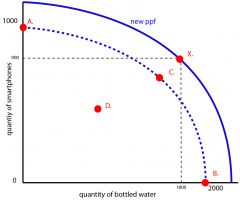![]()
![]()
![]()
Use LEFT and RIGHT arrow keys to navigate between flashcards;
Use UP and DOWN arrow keys to flip the card;
H to show hint;
A reads text to speech;
94 Cards in this Set
- Front
- Back
|
Fundamental principle of Economics |
Resources are Scarce-Scarcity |
|
|
Why Economists study decision making |
Scarcity (of resources) |
|
|
What is Economics |
Study of choice (in relation to resources) |
|
|
Opportunity Cost |
What you give up when choosing one thing over another. |
|
|
Monetary Costs are called |
Explicit Costs (involving spending monies) |
|
|
Non Monetary Costs are called |
Implicit Costs (do not involve direct spending) |
|
|
Rational Choice/Decision making |
Rational people make choices based on rational decision making...weighing pros and cons. **Economists are interested in decisions made at the Margin. (Looking for the impact of an additional or incremental benefit or opportunity cost, and how that affects choice) |
|
|
Specialization and Trade Relationship |
Beneficial in the fact that we as individuals do not have to produce everything we need (or want). i.e. food, clothes, housing, etc. |
|
|
Markets Facilitate? |
Choice (allows buyers and sellers to realize benefits of specialization and trade) |
|
|
Market Prices facilitate |
Opportunity cost (allowing buyers and sellers to make rational choices to best achieve their goals) |
|
|
Four essential resources |
Capital, Natural resources, Labor, Entrepreneurial Skill |
|
|
Capital |
physical capital or human capital. |
|
|
Physical Capital |
Natural resources, Money, Labor hours, Buildings, Materials |
|
|
Human Capital/Human resource |
Abilities, Skills, Knowledge that help economies make or sell goods and services. |
|
|
Natural Resources |
things that can be used in their natural form. Air, Water, Rock, Wind, Land, Minerals, Sunlight, etc. (while these are naturally occurring they are limited but essential, and often held in high demand) |
|
|
Labor |
Physical or Mental work that goes into production for economic gain -or- output of individuals working within a given economy, regardless of what they do. |
|
|
Entrepreneurial Skill |
Includes Knowledge, technology, personal and professional networks, promotion, other tools/techniques that further success of business. |
|
|
Investment |
in economics refers to monetary expenditures put forward to accumulate resources needed to produce goods and services. (Land, Equipment, Technology) |
|
|
Capital Expenditures |
further or increase domestic spending, production capacity, enhances product quality, and promotes advancement through improvement or innovation.
|
|
|
Cost of Capital |
payment of rent, wages, interest, and natural resources |
|
|
Economic Systems, Three Key Questions |
What goods will be produced? How will goods be produced? Who gets the production? |
|
|
Three Types of Economic Systems |
Market Economy Command Economy Traditional Economy |
|
|
Traditional Economy |
key questions are answered in part by custom, and tradition. examples of Traditional Economies are Nomadic and Hunter-Gatherer Societies. |
|
|
Market Economy |
key questions are answered primarily by the forces of supply and demand, and resources are owned privately |
|
|
Command Economy |
economic system in which the government has full control over resources and determines the answer to the key resources |
|
|
Economic Elements |
Socialism/Communism Natural Resources Capitalism Mixed Economies |
|
|
Socialism |
(Government in charge of Society and their actions) Resources used in production of goods and services are owned by the government. Ownership of the resources belongs to everyone as everyone. |
|
|
Socialism Strengths and weaknesses |
PRO:Resource allocation is in favor of the greater population (greater good) CON: Difficult to accumulate wealth, even if working harder and smarter. The system reinforces complacency, undermines efficiency, hinders productivity. Complacency resulsts as lack of incentives, leads to poorer and less efficient economies. CON: Identifying the "greater good" |
|
|
Natural Resources (in Communism) |
Pure Communist Economies would have a complete lack of government intervention, as government fades from existence. (has not happened anywhere yet) PRO: Equality among all in soceity. CON: inability to enforce a complete lack of socioeconomic classes and potential for corruption. CON: shares socialism's complacency and inefficiency. |
|
|
Capitalism |
Individual rights are honored and all resources for production and service are owned by individuals within that society. Pure Capitalistic societies allows no room for government regulation or control over any resource. All citizens are free to provide any good or service, as well as purchase or sell whatever they wish. |
|
|
Capitalism (Pro/Con) |
PRO: main strength is the freedom to produce and trade goods at will, allowing individuals to achieve some form of control over personal wealth. CON: key weakness of pure capitalism there is absolutely no gov't regulation or interference with the production or distribution of goods and services. Capitalistic societies typically overcome the problems of Socialistic and Communistic economies, such as inefficient production and misappropriation of goods. |
|
|
Mixed Economies |
Leverage a combination of Capitalistic/Socialistic/Communistic economies, with that of a capitalistic economy with gov't intervention and regulation. Most economies today are mixed. |
|
|
Market economies depend on multiple factors to build wealth...Those factors are: |
Factors are businesses that produce, buy, sell, or trade resources, goods, and services. Consumers or individuals also play a role on this system. |
|
|
Direct Market Players |
Producers, businesses, and individuals who drive economic activity by buying, and selling goods and services. |
|
|
Business Environement |
Includes regulators and policy makers who influence activity by establishing, or relaxing trade restrictions, raising or lowering taxes, or establishing interest rates. Associations, Loobyistys, and activist groups can also influence the business enviornment by placing pressure on regulatory bodies, policy makers, businesses, and consumers to behave in a way that alters thier decision making. |
|
|
Key differences between Market and Traditional Economy |
Impact Outsiders (Market Players) can have on the who/what/how of economic activity. Market Economy is much larger than a traditional economy. |
|
|
Command System Economies (Communisitic/?) |
Having full control over who produces goods and services, whats produced, and how they are produced and allocated. Key market indicators (supply and demand) are not used to make decisions about what is produced. Lack of visibility into natural demand led to a overwhelming shortage of essential goods and over abundances of others. |
|
|
Mixed Economy Systems: Describe? Dispersed? |
Describe almost every economy in the world. Elements of each system are dispersed throughout the economic systems driving production and trae worldwide. |
|
|
Mirco vs Macro |
small vs big |
|
|
Microeconomics |
study of smaller elements of the economy, or the minutia of the economic system: economic behaviors of local governments, business industries, individual businesses and consumer groups. |
|
|
MAcroeconmics |
insight into the big picture of economic activity: the economic behavior and trends of the overall economy of a country or the world. |
|
|
Gross Domestic Product |
The value of all goods and services produced (More Macro-economical) |
|
|
Ceteris Paribus |
Literally translates to "all things being constant" In economics is used to impose assumptions about the potential for other factors to experience change. i.e. assuming that a cause and effect relationship between two or more variables are not influenced by changes in other variables as those variables are assumed constant and unchanging. Example Gas prices increase dramatically, (ceteris paribus or other factors remaining constant) people will drive less or carpool. Even though there are other reasons people will drive less (bad wx) these factors will not be considered as a potential influence on how much people drive. |
|
|
Scientific Method |
Experimentation in most cases is impractical if even possible for economists... Economists must study situations retrospectively or take advantage of whatever scenario is unfolding before them in the real world. |
|
|
Economist Scientific MEthod |
Ask a Question. Form a Hypothesis Collect Data Test Hypothesis Draw Conclusion |
|
|
Economic Research: pitfalls or limitations |
the result of assumptions economists need to make to limit the scope of the study and take a controlled approach to analyzing whats going on in the economy |
|
|
Ec Research: Fallacy of Composition |
arises when assumption is made that what is true for a sample is true for all. i.e. just b/c a child likes spinach does not mean all do. |
|
|
Ec research: Fallacy of Causation |
assumption is amde that there is a single case for given behavior or outcome. violent video games alone can not be the sole factor for them to grow into violent adults. |
|
|
EC reserach: Ignoring Secondary effects |
Occurs when consideration is not given to unintended consequences of a action or choice. |
|
|
EC Research: Omitted Variables |
occurs witht eh application of ceteris paribus, when only one or two variables are considered to have an effect on economic behavior when in fact there could be other variables. |
|
|
EC Research: Reverse Causality |
Occurs when economists interpret data to determine that a change in one variable is causing the behavior of the other when in fact its the other way around. ex. bigger house makes cause for more stuff or family has stuff which fills a big house? |
|

|
Circular Flow Diagram (similar to a skeletal model in a biology class it helps you understand bare essentials) |
|
|
Factors of Production |
Sold by households to firms and include labor, land, and capital. Those are traded for wages, rent, or profit (income). Goods and services on the other hand are sold by firs and bought byb households. |
|
|
Closed Economy |
Simple circular flow, a high level model of the economy. A closed economy is one in which there is no interaction with outside economies, especially through trade. This is not the norm in most economies. |
|

Production Possibility Frontier |
Graphical depiction of various combinations of goods that can be produced with the available resources and technologies. |
|

Shifts in Production Possibility Frontier |
Frontier Curve can shift when scarce resources become available, or if new technology allows scare resources to produce more. Production can increase Production possibility frontier shifts out: upgrades in tech allows for more made with less moving the frontier out. Previously unattainable points (point x) |
|
|
Monopoly |
No competition, one supplier that holds all market power. Price Setter. |
|
|
Oligopoly |
Market in which there are a few big sellers |
|
|
Monopolistic Competition |
Businesses have larger share of the market and can therefore leverage market power to influence market behavior. |
|
|
Perfect Competition |
Free trade with no government oversight or influence. |
|
|
Diferentiation |
ways that a product differs from similar products of the same market. Four ways a product can be different: Product, Human capitial, marketing, distribution. |
|
|
Product differentataion |
Different size, design, color, shape, performance, functionality, or other features not offered by competition |
|
|
MArket diffentiation |
different through marketing and promotional techniques |
|
|
Service differentiation |
Training service members to provide different or better service to the clientel |
|
|
Differntiation in Distribution |
Sales to clientes by a differnt means, for exmaple Amazon is online vs thier competitors whose sales are all offline and require driving. |
|
|
Location differentiation |
Convienence in location, i.e. gas station on side of highway vice in town |
|
|
Imperfect Information |
companies do not always have the insight leading to making the best possible decision. |
|
|
Price War |
Price wars occur when companies try to underprice the competition to gain market share.
|
|
|
Barriers to Entry |
Barriers to entry are obstacles businesses face in entering a market: high cost of capital, a lack of market share, or legal hurdles.
|
|
|
Cartel
|
A cartel is a formation of oligopolists to control the market by agreeing to production levels, distribution, and price.
|
|
|
Collusion
|
Collusion is an illegal conspiracy to deceive others in business dealings.
|
|
|
Differentiation
|
Differentiation is the effort to make a product or service a little different from similar products or services in the same market.
|
|
|
Differentiation through Distribution
|
Differentiation through distribution strives to make the product or service different by providing a different or enhanced channel of distribution, such as free and easy returns, free shipping, one day delivery, or door to door delivery.
|
|
|
Duopoly
|
A duopoly occurs when there are only two sellers in a market.
|
|
|
Economic Indicators
|
Economic indicators are data used to predict economic behavior in a market.
|
|
|
Game Theory
|
Game theory provides a way to test theory through simulation.
|
|
|
Human Capital Differentiation
|
Human capital differentiation is the effort to make a product or service different from others in the market through customer service and responsiveness.
|
|
|
Imperfect Knowledge
|
Imperfect knowledge occurs when consumers are unable to make a one-to-one comparison of goods in order to make a fully informed and obvious choice.
|
|
|
Imperfectly Competitive Market
|
Imperfectly competitive markets are oligopolies and monopolistic competitive markets because they do not establish an environment for entirely free trade but there is still competition.
|
|
|
Long-run Equilibrium
|
Long-run equilibrium demonstrates the marginal revenue will equal marginal costs at the point where production stops.
|
|
|
Market Differentiation
|
Market differentiation is the use of marketing and advertising to create a perceived difference for the product.
|
|
|
Monopolistic Competition
|
Monopolistic competition occurs when there are businesses that have a larger share of the market and can therefore leverage market power to influence market behavior.
|
|
|
Monopoly |
A monopoly is a market in which there is only one seller.
|
|
|
Monopolistic Competitive Market
|
A monopolistic competitive market is one in which few large sellers compete with one another.
|
|
|
Nash Equilibrium
|
Nash equilibrium is the appearance of equilibrium achieved in a duopoly.
|
|
|
Oligopoly
|
An oligopoly is a market in which there are a few big sellers.
|
|
|
Perfect Competition
|
Perfect competition is free trade with no government oversight or interference.
|
|
|
Perfect Substitute:
|
A perfect substitute occurs when a product from one seller is identical to that of another seller.
|
|
|
Policy Makers
|
Policy makers are those in power to influence market regulation.
|
|
|
Price Fixing
|
Price fixing is when firms get together and agree to charge a specific price for a good, often to undercut competitors.
|
|
|
Price Wars
|
Price wars occur when companies try to underprice the competition to gain market share.
|
|
|
Prisoner's Dilemma
|
Prisoner's dilemma is a game that uses game theory to demonstrate the decision making process that two opposing forces, such as oligopolies, may face.
|
|
|
Product Differentiation
|
Product differentiation is creating a difference in the product itself, such as added services, functionality, or durability.
|
|
|
Value
|
Value is the perceived benefit one receives from a product service.
|

